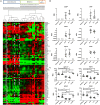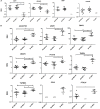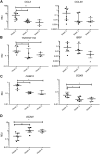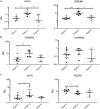Gene Expression Signatures of Synovial Fluid Multipotent Stromal Cells in Advanced Knee Osteoarthritis and Following Knee Joint Distraction
- PMID: 33178674
- PMCID: PMC7591809
- DOI: 10.3389/fbioe.2020.579751
Gene Expression Signatures of Synovial Fluid Multipotent Stromal Cells in Advanced Knee Osteoarthritis and Following Knee Joint Distraction
Abstract
Osteoarthritis (OA) is the most common musculoskeletal disorder. Although joint replacement remains the standard of care for knee OA patients, knee joint distraction (KJD), which works by temporarily off-loading the joint for 6-8 weeks, is becoming a novel joint-sparing alternative for younger OA sufferers. The biological mechanisms behind KJD structural improvements remain poorly understood but likely involve joint-resident regenerative cells including multipotent stromal cells (MSCs). In this study, we hypothesized that KJD leads to beneficial cartilage-anabolic and anti-catabolic changes in joint-resident MSCs and investigated gene expression profiles of synovial fluid (SF) MSCs following KJD as compared with baseline. To obtain further insights into the effects of local biomechanics on MSCs present in late OA joints, SF MSC gene expression was studied in a separate OA arthroplasty cohort and compared with subchondral bone (SB) MSCs from medial (more loaded) and lateral (less loaded) femoral condyles from the same joints. In OA arthroplasty cohort (n = 12 patients), SF MSCs expressed lower levels of ossification- and hypotrophy-related genes [bone sialoprotein (IBSP), parathyroid hormone 1 receptor (PTH1R), and runt-related transcription factor 2 (RUNX2)] than did SB MSCs. Interestingly, SF MSCs expressed 5- to 50-fold higher levels of transcripts for classical extracellular matrix turnover molecules matrix metalloproteinase 1 (MMP1), a disintegrin and metalloproteinase with thrombospondin motifs 5 (ADAMTS5), and tissue inhibitor of metalloproteinase-3 (TIMP3), all (p < 0.05) potentially indicating greater cartilage remodeling ability of OA SF MSCs, compared with SB MSCs. In KJD cohort (n = 9 patients), joint off-loading resulted in sustained, significant increase in SF MSC colonies' sizes and densities and a notable transcript upregulation of key cartilage core protein aggrecan (ACAN) (weeks 3 and 6), as well as reduction in pro-inflammatory C-C motif chemokine ligand 2 (CCL2) expression (weeks 3 and 6). Additionally, early KJD changes (week 3) were marked by significant increases in MSC chondrogenic commitment markers gremlin 1 (GREM1) and growth differentiation factor 5 (GDF5). In combination, our results reveal distinct transcriptomes on joint-resident MSCs from different biomechanical environments and show that 6-week joint off-loading leads to transcriptional changes in SF MSCs that may be beneficial for cartilage regeneration. Biomechanical factors should be certainly considered in the development of novel MSC-based therapies for OA.
Keywords: chondrocytes; knee joint distraction; multipotent stromal cells; osteoarthritis; subchondral bone; synovial fluid.
Copyright © 2020 Sanjurjo-Rodriguez, Altaie, Mastbergen, Baboolal, Welting, Lafeber, Pandit, McGonagle and Jones.
Figures






Similar articles
-
Synovial fluid hyaluronan mediates MSC attachment to cartilage, a potential novel mechanism contributing to cartilage repair in osteoarthritis using knee joint distraction.Ann Rheum Dis. 2016 May;75(5):908-15. doi: 10.1136/annrheumdis-2014-206847. Epub 2015 May 6. Ann Rheum Dis. 2016. PMID: 25948596 Free PMC article.
-
Harnessing knee joint resident mesenchymal stem cells in cartilage tissue engineering.Acta Biomater. 2023 Sep 15;168:372-387. doi: 10.1016/j.actbio.2023.07.024. Epub 2023 Jul 21. Acta Biomater. 2023. PMID: 37481194 Review.
-
The molecular profile of synovial fluid changes upon joint distraction and is associated with clinical response in knee osteoarthritis.Osteoarthritis Cartilage. 2020 Mar;28(3):324-333. doi: 10.1016/j.joca.2019.12.005. Epub 2020 Jan 2. Osteoarthritis Cartilage. 2020. PMID: 31904489 Free PMC article.
-
In vitro and in vivo potentialities for cartilage repair from human advanced knee osteoarthritis synovial fluid-derived mesenchymal stem cells.Stem Cell Res Ther. 2018 Nov 28;9(1):329. doi: 10.1186/s13287-018-1071-2. Stem Cell Res Ther. 2018. PMID: 30486903 Free PMC article.
-
Native joint-resident mesenchymal stem cells for cartilage repair in osteoarthritis.Nat Rev Rheumatol. 2017 Dec;13(12):719-730. doi: 10.1038/nrrheum.2017.182. Epub 2017 Nov 9. Nat Rev Rheumatol. 2017. PMID: 29118440 Review.
Cited by
-
Attenuation of osteoarthritis progression through intra-articular injection of a combination of synovial membrane-derived MSCs (SMMSCs), platelet-rich plasma (PRP) and conditioned medium (secretome).J Orthop Surg Res. 2022 Feb 17;17(1):102. doi: 10.1186/s13018-021-02851-2. J Orthop Surg Res. 2022. PMID: 35177103 Free PMC article.
-
Women's contribution to stem cell research for osteoarthritis: an opinion paper.Front Cell Dev Biol. 2023 Dec 19;11:1209047. doi: 10.3389/fcell.2023.1209047. eCollection 2023. Front Cell Dev Biol. 2023. PMID: 38174070 Free PMC article. Review. No abstract available.
-
Mesenchymal stem cells in synovial fluid increase in number in response to synovitis and display more tissue-reparative phenotypes in osteoarthritis.Stem Cell Res Ther. 2023 Sep 8;14(1):244. doi: 10.1186/s13287-023-03487-1. Stem Cell Res Ther. 2023. PMID: 37679780 Free PMC article.
-
Harnessing joint distraction for the treatment of osteoarthritis: a bibliometric and visualized analysis.Front Bioeng Biotechnol. 2023 Nov 9;11:1309688. doi: 10.3389/fbioe.2023.1309688. eCollection 2023. Front Bioeng Biotechnol. 2023. PMID: 38026890 Free PMC article.
-
Osteoarthritis as an evolutionary legacy: Biological ageing and chondrocyte hypertrophy.Osteoarthr Cartil Open. 2025 May 13;7(3):100624. doi: 10.1016/j.ocarto.2025.100624. eCollection 2025 Sep. Osteoarthr Cartil Open. 2025. PMID: 40492024 Free PMC article. Review.
References
-
- Amemiya M., Tsuji K., Katagiri H., Miyatake K., Nakagawa Y., Sekiya I., et al. (2020). Synovial fluid-derived mesenchymal cells have non-inferior chondrogenic potential and can be utilized for regenerative therapy as substitute for synovium-derived cells. Biochem. Biophys. Res. Commun. 523 465–472. 10.1016/j.bbrc.2019.12.068 - DOI - PubMed
Grants and funding
LinkOut - more resources
Full Text Sources

